Submitted:
14 May 2024
Posted:
15 May 2024
You are already at the latest version
Abstract
Keywords:
1. Introduction
2. Materials and Methods
2.1. Study Area
2.2. Data Collection
2.2.1. Weather Data
2.2.2. Discharge Data
with hs = R × T/M × g
2.2.3. Gridded Precipitation Data: IMERG
2.2.4. SPATIAL Data
2.3. Rainfall Spatial Variability
2.4. Hydrological Modelling : SWAT Semi-Distributed Model
2.4.1. Model Description
2.4.2. Sensitivity Analysis, Calibration and Validation
2.4.3. Scenarios
2.4.3. Hydrological Model Performance
| Name/Symbol | Formula | Optimal value |
| Coefficient of determination/ R² | 1 | |
| Slope of linear regression/ a | Qs=a(Qm) + b | 1 |
| Nash-Sutcliffe efficiency/ NSE | 1 | |
| Root-Mean-Square Error/ RMSE | 0 | |
| Kling-Gupta Efficiency/ KGE | 1 |
3. Results
3.1. Hydrological Modelling : SWAT Semi-Distributed Model
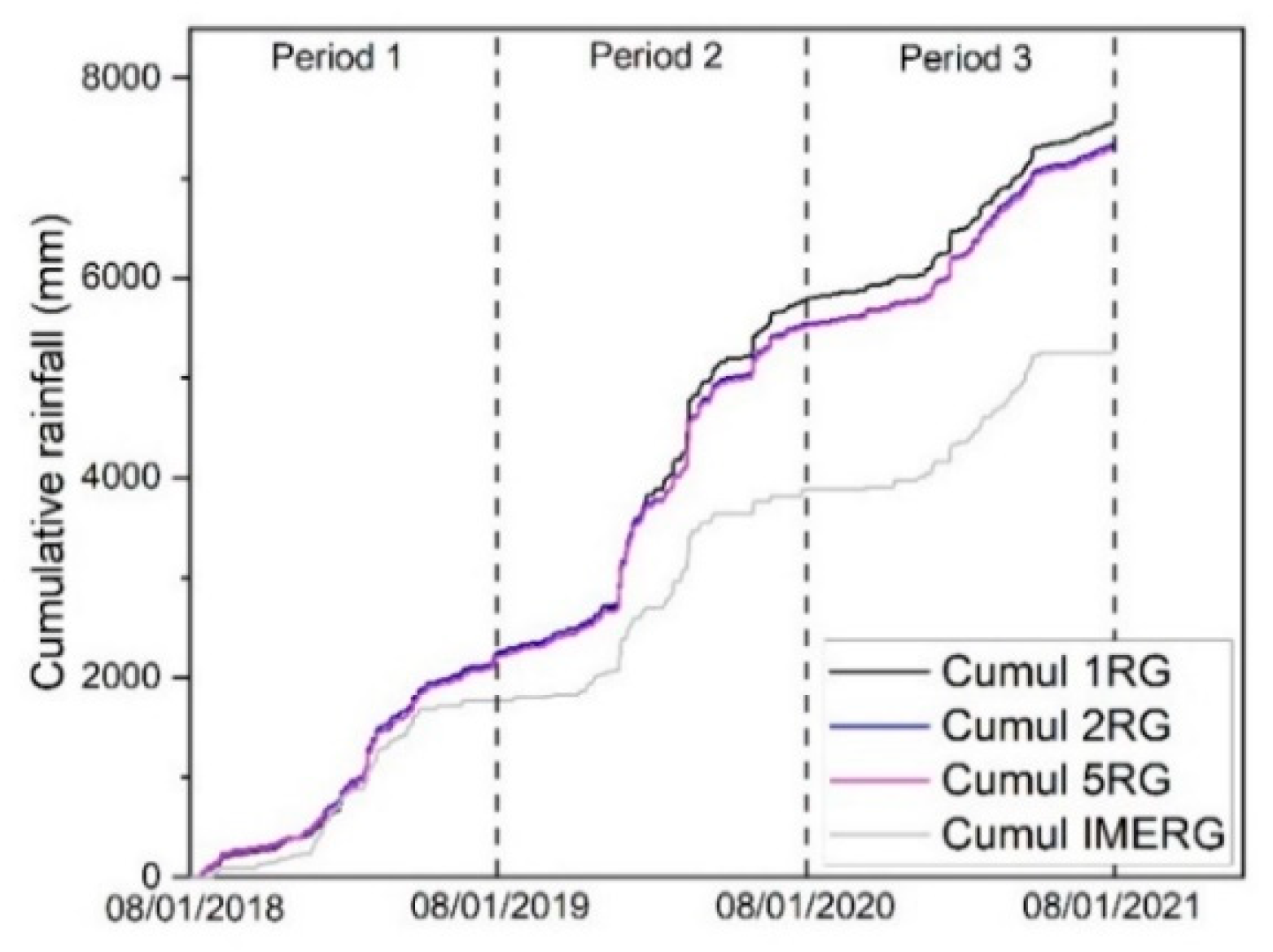
3.2. Streamfolw Characteristics
3.3. Rainfall-Runoff Model Performances
3.3.1. Overall Performance
3.3.2. Performance across Discharge Classes
4. Discussion
4.1. Rainfall Characteristics
4.2. Hydrological Usefulness of Precipitation Data
4.3. Implication of the Selection of Precipitations Datasets in Streamflow Simulation
5. Conclusions
- Our findings can be summarized as follows:
- The utilization of a network of multiple rain gauges offers a more accurate depiction of the spatial variability of precipitation in tropical mountainous regions, surpassing the representation provided by a single rain gauge or IMERG satellite-based precipitation data.
- The performance of the SWAT model, driven by four different precipitation datasets, decreased in the order 5RG > 2RG > 1RG > IMERG, indicating the effectiveness of a denser network for capturing rainfall variability in high-altitude watersheds.
- Rain gauge scenarios performed better for accurate flood and low-flow forecasting.
- Despite underestimating extreme precipitation and peak flow, IMERG achieved quite good performance based on statistical indicators. However, the use of IMERG rainfall as input data for hydrological applications comes with several limitations, including the physical significance of the parameters.
- While IMERG data are readily available at low cost, its lower performance in hydrological modeling introduces significant uncertainty into the results. In comparison, the 2RG network configuration achieved satisfactory streamflow simulation and remains the most cost-effective option for establishing reliable hydrological observatories in this particular study area, considering its characteristics.
Author Contributions
Funding
Acknowledgments
Conflicts of Interest
Appendix A
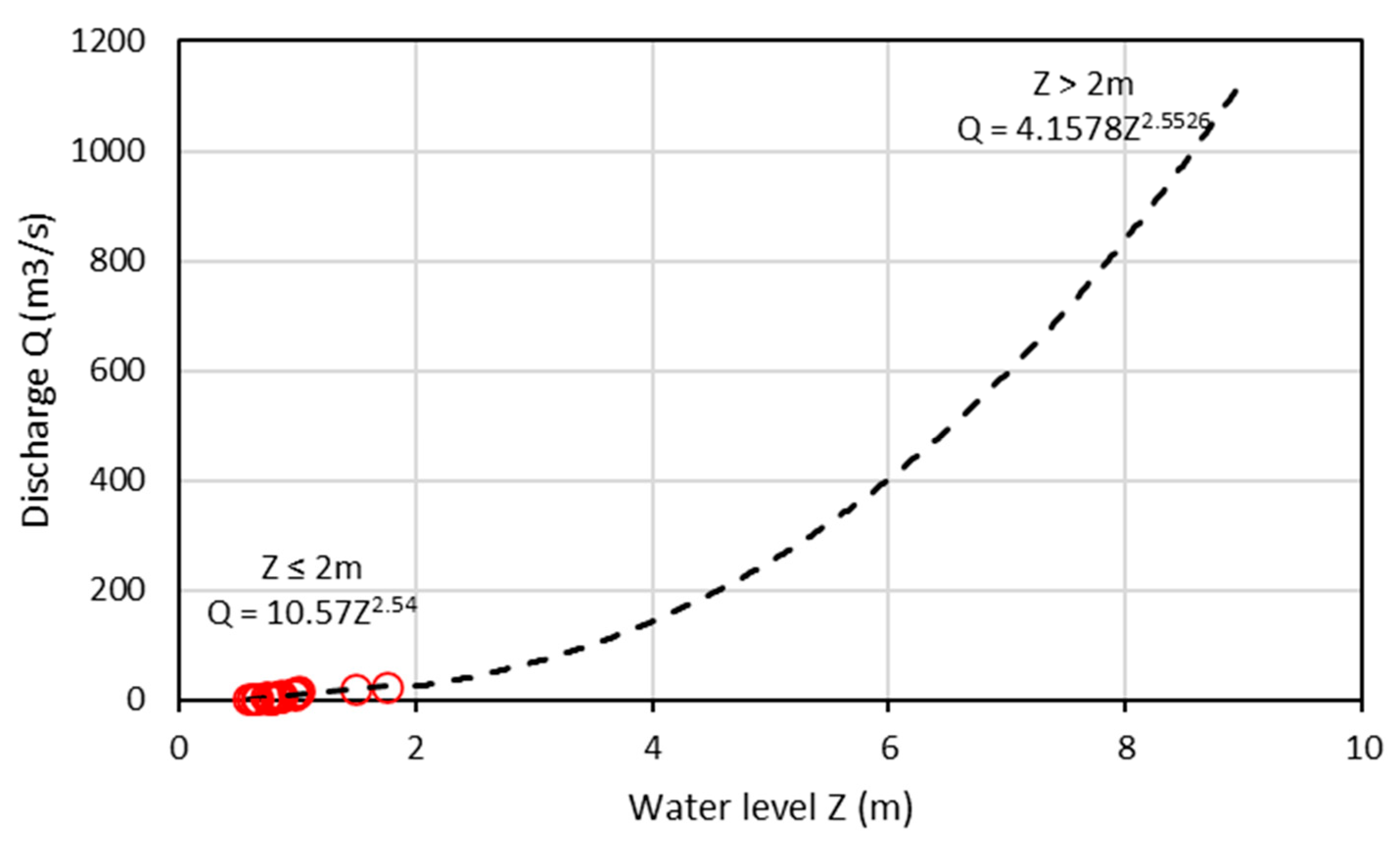
References
- Di Baldassarre, G.; Montanari, A.; Lins, H.; Koutsoyiannis, D.; Brandimarte, L.; Blöschl, G. Flood Fatalities in Africa: From Diagnosis to Mitigation. Geophysical Research Letters 2010, 37. [Google Scholar]
- Carrière, S.D.; Health, T.; Rakotomandrindra, P.F.M.; Ollivier, C.; Rajaomahefasoa, R.E.; Rakoto, H.A.; Lapègue, J.; Rakotoarison, Y.E.; Mangin, M.; Kempf, J.; et al. Long-Term Groundwater Resource Observatory for Southwestern Madagascar. Hydrological Processes 2021, 35, e14108. [Google Scholar] [CrossRef]
- WMO Climate Change Increased Extreme Rainfall in Southeast Africa Storms - Madagascar Available online:. https://reliefweb.int/report/madagascar/climate-change-increased-extreme-rainfall-southeast-africa-storms (accessed on 2 October 2022).
- WMO Tropical Hydrology 1987.
- Sivakumar, B. Chaos in Hydrology; Springer Netherlands: Dordrecht, 2017; ISBN 978-90-481-2551-7. [Google Scholar]
- Sivapalan, M.; Takeuchi, K.; Franks, S.W.; Gupta, V.K.; Karambiri, H.; Lakshmi, V.; Liang, X.; McDONNELL, J.J.; Mendiondo, E.M.; O’Connell, P.E.; et al. IAHS Decade on Predictions in Ungauged Basins (PUB), 2003–2012: Shaping an Exciting Future for the Hydrological Sciences. Hydrological Sciences Journal 2003, 48, 857–880. [Google Scholar] [CrossRef]
- Sun, Q.; Miao, C.; Duan, Q.; Ashouri, H.; Sorooshian, S.; Hsu, K. A Review of Global Precipitation Data Sets: Data Sources, Estimation, and Intercomparisons. Rev. Geophys. 2018, 56, 79–107. [Google Scholar] [CrossRef]
- Tapiador, F.J.; Turk, F.J.; Petersen, W.; Hou, A.Y.; García-Ortega, E.; Machado, L.A.; Angelis, C.F.; Salio, P.; Kidd, C.; Huffman, G.J. Global Precipitation Measurement: Methods, Datasets and Applications. Atmospheric Research 2012, 104, 70–97. [Google Scholar]
- Ombadi, M.; Nguyen, P.; Sorooshian, S.; Hsu, K. Developing Intensity-Duration-Frequency (IDF) Curves From Satellite-Based Precipitation: Methodology and Evaluation. Water Resources Research 2018, 54, 7752–7766. [Google Scholar] [CrossRef]
- Maggioni, V.; Massari, C. On the Performance of Satellite Precipitation Products in Riverine Flood Modeling: A Review. Journal of hydrology 2018, 558, 214–224. [Google Scholar]
- Gosset, M.; Viarre, J.; Quantin, G.; Alcoba, M. Evaluation of Several Rainfall Products Used for Hydrological Applications over West Africa Using Two High-Resolution Gauge Networks. Quarterly Journal of the Royal Meteorological Society 2013, 139, 923–940. [Google Scholar] [CrossRef]
- Villarini, G.; Krajewski, W.F.; Ciach, G.J.; Zimmerman, D.L. Product-Error-Driven Generator of Probable Rainfall Conditioned on WSR-88D Precipitation Estimates. Water Resources Research 2009, 45. [Google Scholar]
- Khan, S. Evaluating High-Resolution Satellite Precipitation Products Globally Over Land and Oceans. PhD Thesis, George Mason University, 2019.
- Kummerow, C.; Barnes, W.; Kozu, T.; Shiue, J.; Simpson, J. The Tropical Rainfall Measuring Mission (TRMM) Sensor Package. Journal of atmospheric and oceanic technology 1998, 15, 809–817. [Google Scholar]
- Huffman, G.J.; Bolvin, D.T.; Braithwaite, D.; Hsu, K.-L.; Joyce, R.J.; Kidd, C.; Nelkin, E.J.; Sorooshian, S.; Stocker, E.F.; Tan, J. Integrated Multi-Satellite Retrievals for the Global Precipitation Measurement (GPM) Mission (IMERG). In Satellite Precipitation Measurement; Springer, 2020; pp. 343–353.
- Ramahaimandimby, Z.; Randriamaherisoa, A.; Jonard, F.; Vanclooster, M.; Bielders, C.L. Reliability of Gridded Precipitation Products for Water Management Studies: The Case of the Ankavia River Basin in Madagascar. Remote Sensing 2022, 14, 3940. [Google Scholar] [CrossRef]
- Tan, M.L.; Duan, Z. Assessment of GPM and TRMM Precipitation Products over Singapore. Remote Sensing 2017, 9, 720. [Google Scholar] [CrossRef]
- Derin, Y.; Kirstetter, P.-E.; Gourley, J.J. Evaluation of IMERG Satellite Precipitation over the Land–Coast–Ocean Continuum. Part I: Detection. Journal of Hydrometeorology 2021, 22, 2843–2859. [Google Scholar] [CrossRef]
- Dezfuli, A.K.; Ichoku, C.M.; Huffman, G.J.; Mohr, K.I.; Selker, J.S.; van de Giesen, N.; Hochreutener, R.; Annor, F.O. Validation of IMERG Precipitation in Africa. J. Hydrometeor. 2017, 18, 2817–2825. [Google Scholar] [CrossRef]
- Sellami, H.; La Jeunesse, I.; Benabdallah, S.; Vanclooster, M. Parameter and Rating Curve Uncertainty Propagation Analysis of the SWAT Model for Two Small Mediterranean Catchments. Hydrological Sciences Journal 2013, 58, 1635–1657. [Google Scholar] [CrossRef]
- Jiang, Q.; Li, W.; Fan, Z.; He, X.; Sun, W.; Chen, S.; Wen, J.; Gao, J.; Wang, J. Evaluation of the ERA5 Reanalysis Precipitation Dataset over Chinese Mainland. Journal of Hydrology 2021, 595, 125660. [Google Scholar] [CrossRef]
- Li, N.; Tang, G.; Zhao, P.; Hong, Y.; Gou, Y.; Yang, K. Statistical Assessment and Hydrological Utility of the Latest Multi-Satellite Precipitation Analysis IMERG in Ganjiang River Basin. Atmospheric Research 2017, 183, 212–223. [Google Scholar] [CrossRef]
- Tang, G.; Zeng, Z.; Long, D.; Guo, X.; Yong, B.; Zhang, W.; Hong, Y. Statistical and Hydrological Comparisons between TRMM and GPM Level-3 Products over a Midlatitude Basin: Is Day-1 IMERG a Good Successor for TMPA 3B42V7? Journal of Hydrometeorology 2016, 17, 121–137. [Google Scholar]
- Jiang, S.; Ren, L.; Xu, C.-Y.; Yong, B.; Yuan, F.; Liu, Y.; Yang, X.; Zeng, X. Statistical and Hydrological Evaluation of the Latest Integrated Multi-satellitE Retrievals for GPM (IMERG) over a Midlatitude Humid Basin in South China. Atmospheric Research 2018, 214, 418–429. [Google Scholar] [CrossRef]
- Wang, Z.; Zhong, R.; Lai, C.; Chen, J. Evaluation of the GPM IMERG Satellite-Based Precipitation Products and the Hydrological Utility. Atmospheric Research 2017, 196, 151–163. [Google Scholar] [CrossRef]
- Su, J.; Li, X.; Ren, W.; Lü, H.; Zheng, D. How Reliable Are the Satellite-Based Precipitation Estimations in Guiding Hydrological Modelling in South China? Journal of Hydrology 2021, 602, 126705. [Google Scholar] [CrossRef]
- Jiang, L.; Bauer-Gottwein, P. How Do GPM IMERG Precipitation Estimates Perform as Hydrological Model Forcing? Evaluation for 300 Catchments across Mainland China. Journal of Hydrology 2019, 572, 486–500. [Google Scholar] [CrossRef]
- Yuan, F.; Wang, B.; Shi, C.; Cui, W.; Zhao, C.; Liu, Y.; Ren, L.; Zhang, L.; Zhu, Y.; Chen, T.; et al. Evaluation of Hydrological Utility of IMERG Final Run V05 and TMPA 3B42V7 Satellite Precipitation Products in the Yellow River Source Region, China. Journal of Hydrology 2018, 567, 696–711. [Google Scholar] [CrossRef]
- Mahmoud, M.T.; Mohammed, S.A.; Hamouda, M.A.; Mohamed, M.M. Impact of Topography and Rainfall Intensity on the Accuracy of IMERG Precipitation Estimates in an Arid Region. Remote Sensing 2021, 13, 13. [Google Scholar] [CrossRef]
- CREAM Monographie de La Région SAVA 2013. Available online: http://www.monographiemada.com/ (accessed on 23 July 2022).
- Tadross, M.; Randriamarolaza, L.; Rabefitia, Z.; Zheng, K.Y. Climate Change in Madagascar; Recent Past and Future. Washington, DC: World Bank 2008, 18.
- CPGU Atlas de La Vulnérabilité Sectorielle de La Région SAVA. Cellule de Prevention et de la Gestion des Urgences: Antananarivo, Madagascar. 2012.
- Jury, M.R.; Parker, B.A.; Raholijao, N.; Nassor, A. Variability of Summer Rainfall over Madagascar: Climatic Determinants at Interannual Scales. International journal of climatology 1995, 15, 1323–1332. [Google Scholar] [CrossRef]
- Chaperon, P.; Danloux, J.; Ferry, L. Fleuves et Rivières de Madagascar. Monographies hydrologiques ORSTOM 1993, 14–854. [Google Scholar]
- Pamela Probst, C.P. Tropical Cyclone ENAWO Post-Event Report 2017.
- Ormsby, A.; Mannle, K. Ecotourism Benefits and the Role of Local Guides at Masoala National Park, Madagascar. Journal of Sustainable Tourism 2006, 14, 271–287. [Google Scholar] [CrossRef]
- Hengl, T.; Mendes de Jesus, J.; Heuvelink, G.B.M.; Ruiperez Gonzalez, M.; Kilibarda, M.; Blagotić, A.; Shangguan, W.; Wright, M.N.; Geng, X.; Bauer-Marschallinger, B.; et al. SoilGrids250m: Global Gridded Soil Information Based on Machine Learning. PLoS ONE 2017, 12, e0169748. [Google Scholar] [CrossRef]
- Martinez, P.; Souza, I.F. Genesis of Pseudo-Sand Structure in Oxisols from Brazil – A Review. Geoderma Regional 2020, 22, e00292. [Google Scholar] [CrossRef]
- Rossi, G. L’érosion à Madagascar: L’importance Des Facteurs Humains. Cahiers d’outre-mer 1979, 32, 355–370. [Google Scholar] [CrossRef]
- Phillips, J.V.; Tadayon, S. Selection of Manning’s Roughness Coefficient for Natural and Constructed Vegetated and Non-Vegetated Channels, and Vegetation Maintenance Plan Guidelines for Vegetated Channels in Central Arizona; US Geological Survey, 2006.
- Bontemps, S.; Defourny, P.; Van Bogaert, E.; Team, E.S.A.; Arino, O.; Kalogirou, V.; Perez, J.R. GLOBCOVER 2009 Products Description and Validation Report. 2009.
- Deckers, J.; Nachtergaele, F.; Spaargaren, O. Tropical Soils in the Classification Systems of USDA, FAO and WRB. Evolution of Tropical Soil Science 2010, 79. [Google Scholar]
- Earth Resources Observation And Science (EROS) Center Shuttle Radar Topography Mission (SRTM) 1 Arc-Second Global. Available online: https://www.usgs.gov/centers/eros/science/usgs-eros-archive-digital-elevation-shuttle-radar-topography-mission-srtm-1 (accessed on 03 June 2022), 2017.
- Jalilibal, Z.; Amiri, A.; Castagliola, P.; Khoo, M.B.C. Monitoring the Coefficient of Variation: A Literature Review. Computers & Industrial Engineering 2021, 161, 107600. [Google Scholar] [CrossRef]
- Arnold, J.G.; Moriasi, D.N.; Gassman, P.W.; Abbaspour, K.C.; White, M.J.; Srinivasan, R.; Santhi, C.; Harmel, R.D.; Van Griensven, A.; Van Liew, M.W. SWAT: Model Use, Calibration, and Validation. Transactions of the ASABE 2012, 55, 1491–1508. [Google Scholar] [CrossRef]
- Fleuves et Rivières de Madagascar; Chaperon et al. , C., Ed.; Monographies hydrologiques ORSTOM; Office de la recherche scientifique et technique outre-mer: Paris, 1974; ISBN 978-2-7099-0344-8. [Google Scholar]
- Huffman, G.J.; Bolvin, D.T.; Nelkin, E.J. Integrated Multi-satellitE Retrievals for GPM (IMERG) Technical Documentation. NASA/GSFC Code 2015, 612, 47. [Google Scholar]
- Randriatsara, H.H.-R.H.; Hu, Z.; Ayugi, B.; Makula, E.K.; Vuguziga, F.; Nkunzimana, A. Interannual Characteristics of Rainfall over Madagascar and Its Relationship with the Indian Ocean Sea Surface Temperature Variation. Theor Appl Climatol 2022. [Google Scholar] [CrossRef]
- Leigh, E.G. Structure and Climate in Tropical Rain Forest. Annual review of ecology and systematics 1975, 67–86. [Google Scholar] [CrossRef]
- Bayat, B.; Hosseini, K.; Nasseri, M.; Karami, H. Challenge of Rainfall Network Design Considering Spatial versus Spatiotemporal Variations. Journal of Hydrology 2019, 574, 990–1002. [Google Scholar] [CrossRef]
- Hohmann, C.; Kirchengast, G.; O, S.; Rieger, W.; Foelsche, U. Runoff Sensitivity to Spatial Rainfall Variability: A Hydrological Modeling Study with Dense Rain Gauge Observations. Hydrology and Earth System Sciences Discussions 2020, 1–28. [Google Scholar] [CrossRef]
- Getirana, A.; Kirschbaum, D.; Mandarino, F.; Ottoni, M.; Khan, S.; Arsenault, K. Potential of GPM IMERG Precipitation Estimates to Monitor Natural Disaster Triggers in Urban Areas: The Case of Rio de Janeiro, Brazil. Remote Sensing 2020, 12, 4095. [Google Scholar] [CrossRef]
- Krause, P.; Boyle, D.P.; Bäse, F. Comparison of Different Efficiency Criteria for Hydrological Model Assessment. Advances in Geosciences 2005, 5, 89–97. [Google Scholar] [CrossRef]
- Musy, A. Hydrology: A Science for Engineers. 2004, 583.
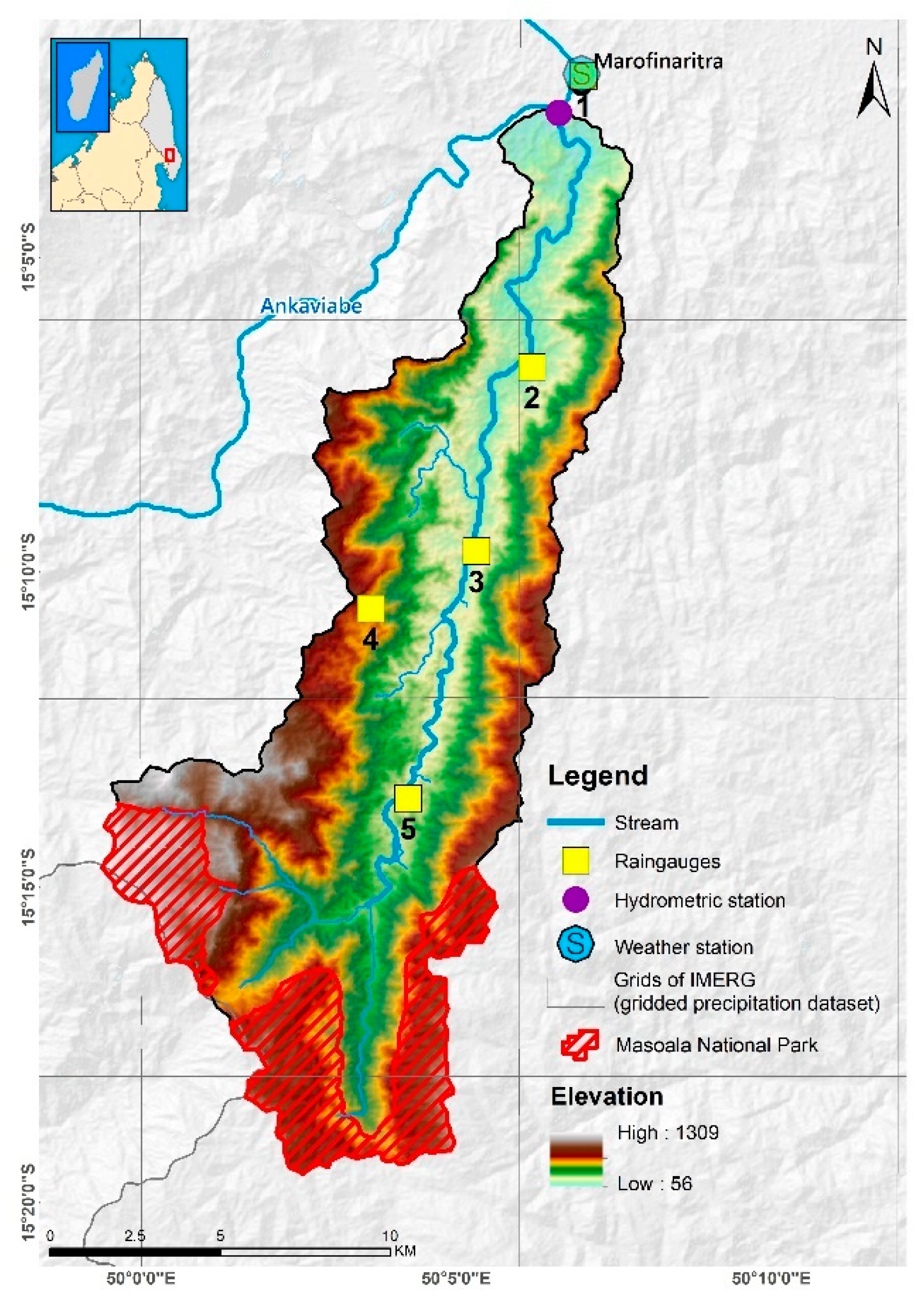
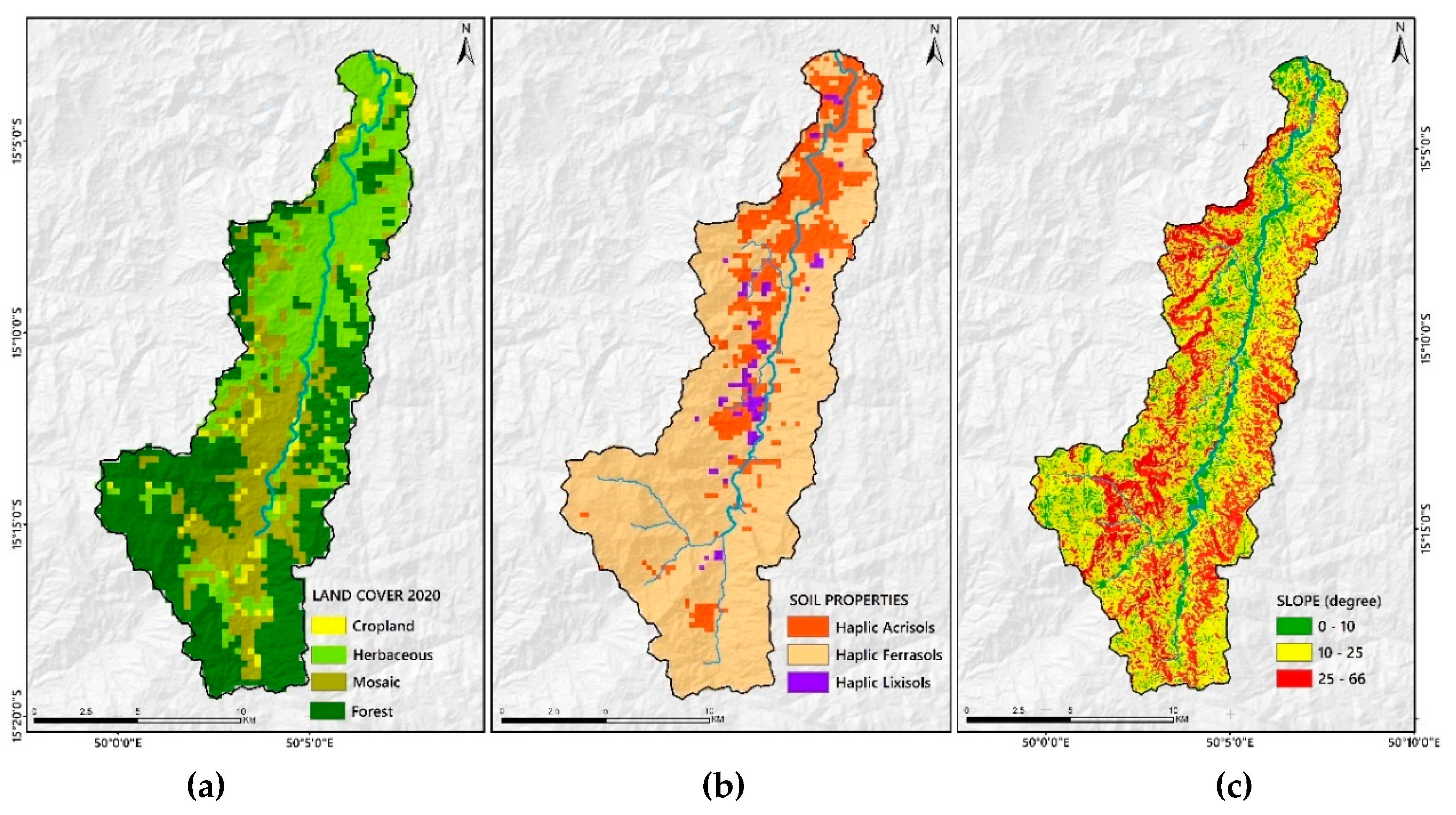
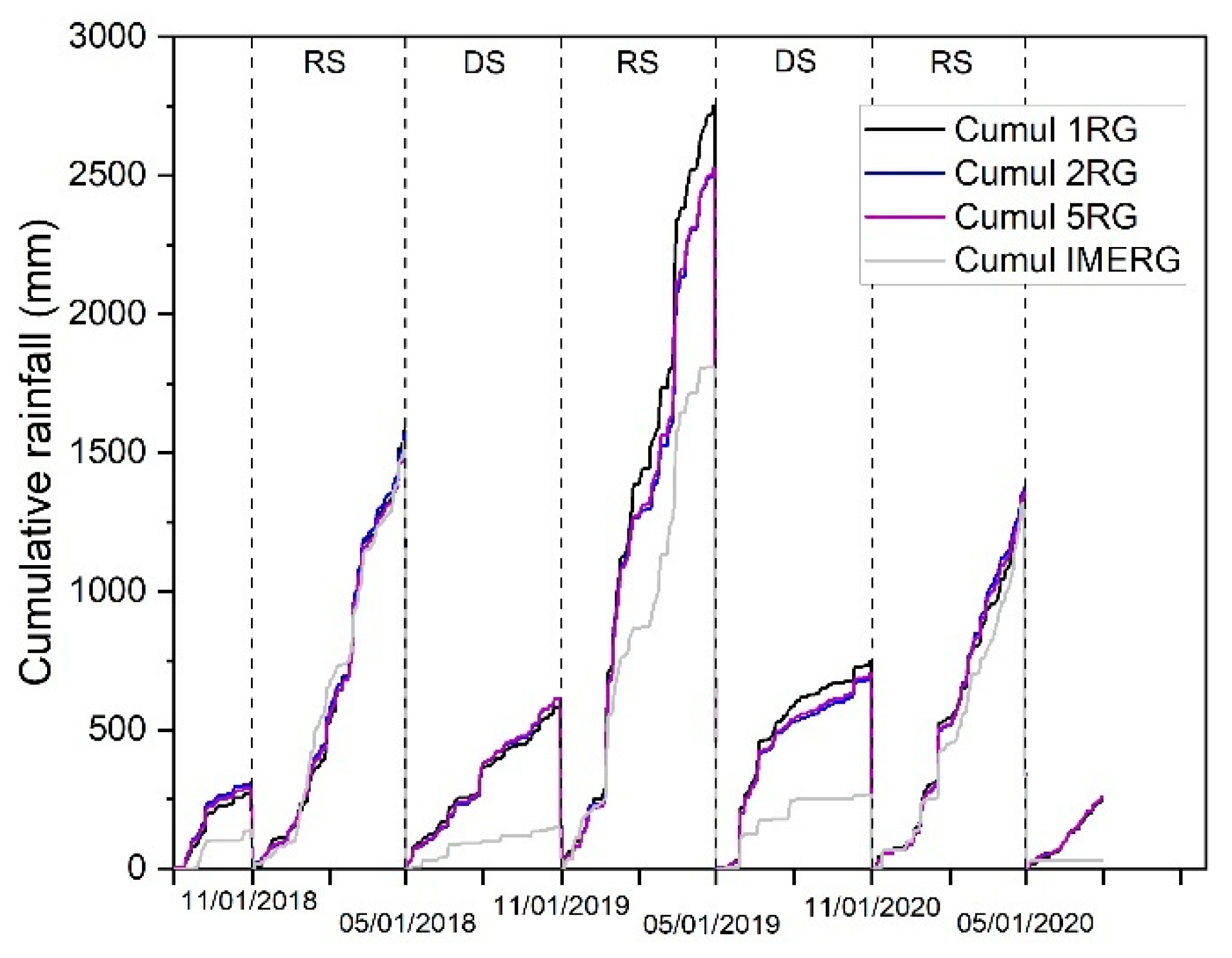
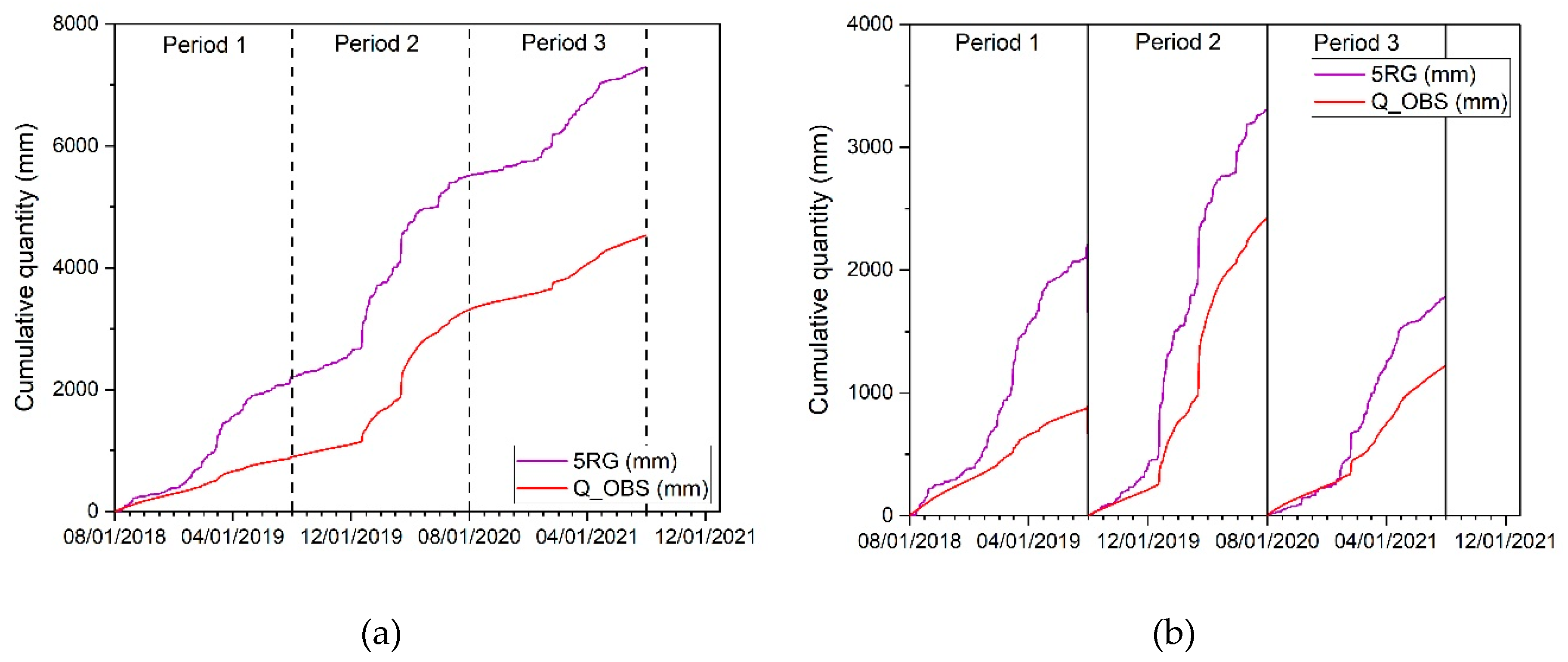
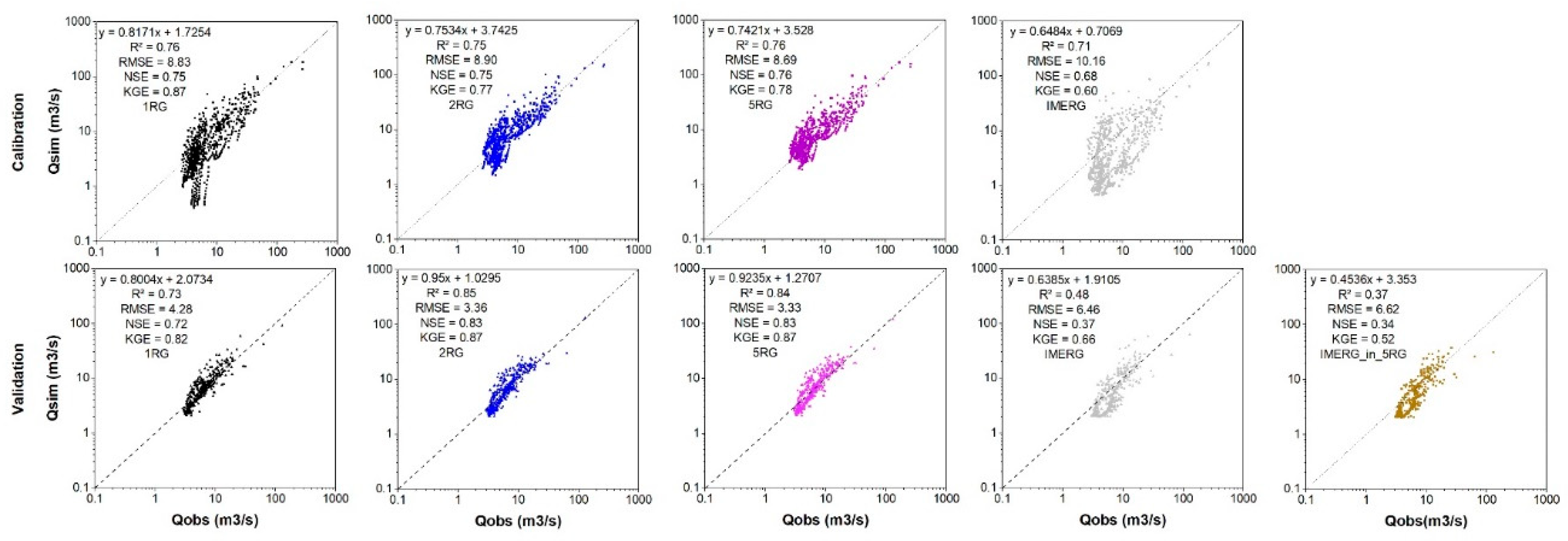
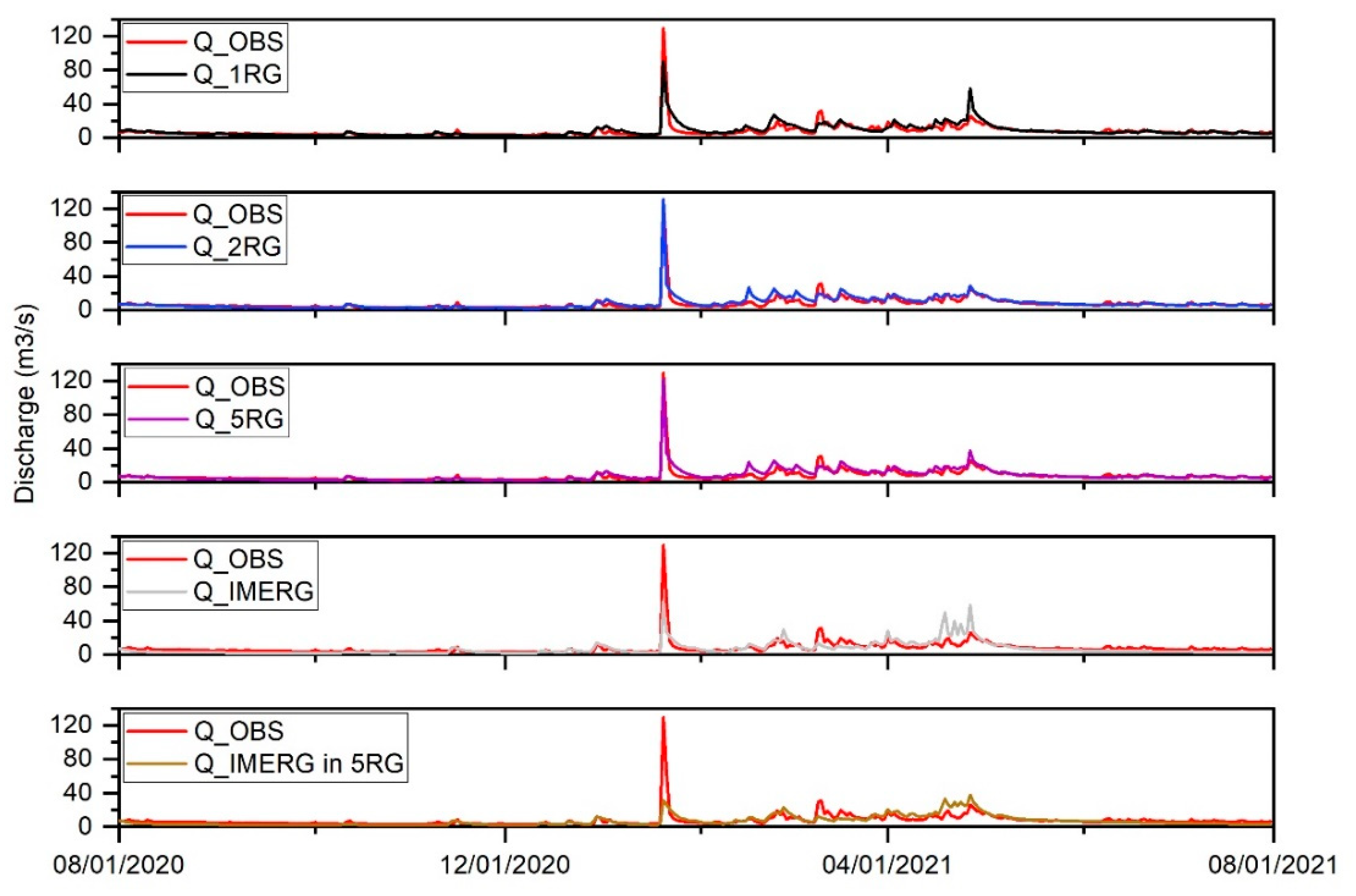

| Parameters | Description | Range | Initial value | 1RG | 2RG | 5RG | IMERG | |
|---|---|---|---|---|---|---|---|---|
| Min | Max | |||||||
| 1: CN2 | Multiplication factor for SCS runoff curve number | 0 | 1 | 0.5 | 0.506 | 0.563 | 0.545 | 0.834 |
| 2: SOL_AWC | Multiplication factor for available water capacity of the soil layer | 0 | 1 | 1 | 0.774 | 0.649 | 0.686 | 0.879 |
| 3: GW_DELAY | Groundwater delay (days) | 0 | 450 | 31 | 367 | 58 | 72 | 70 |
| 4: GWQMN | Threshold depth of water in the shallow aquifer required for return flow to occur (mm) | 0 | 5000 | 1000 | 1097 | 922 | 4982 | 1572 |
| 5: SHALLST | Initial depth of water in the shallow aquifer (mm) | 0 | 5000 | 1000 | 802 | 2442 | 1002 | 2697 |
| 6: DEEPST | Initial depth of water in the deep aquifer (mm) | 0 | 10000 | 2000 | 8115 | 7725 | 5275 | 9555 |
| 7: GW_REVAP | Groundwater “revap” coefficient | 0.02 | 0.2 | 0.02 | 0.081 | 0.105 | 0.113 | 0.120 |
| 8: RCHRG_DP | Deep aquifer percolation fraction | 0 | 1 | 0.05 | 0.3 | 0.4 | 0.9 | 0.8 |
| 9: GWHT | Initial groundwater height (m) | 0 | 25 | 1 | 6.4 | 22.0 | 12.0 | 6.3 |
| 10: GW_SPYLD | Specific yield of the shallow aquifer (m3/m3) | 0 | 0.4 | 0.003 | 0.3 | 0.2 | 0.2 | 0.3 |
| Period (MM/DD/YYYY) | CV 5RG (%) | Cumulative rainfall 5RG | CV IMERG (%) | Cumulative rainfall IMERG |
| Period 1 (08/01/2018 – 07/31/2019) | 71.9 | 2100 | 70.2 | 1721 |
| Period 2 (08/01/2019 – 07/31/2020) | 73.8 | 3350 | 62.9 | 2121 |
| Period 3 (08/01/2020 – 07/03/2021) | 63.4 | 1806 | 60.3 | 1370 |
Disclaimer/Publisher’s Note: The statements, opinions and data contained in all publications are solely those of the individual author(s) and contributor(s) and not of MDPI and/or the editor(s). MDPI and/or the editor(s) disclaim responsibility for any injury to people or property resulting from any ideas, methods, instructions or products referred to in the content. |
© 2024 by the authors. Licensee MDPI, Basel, Switzerland. This article is an open access article distributed under the terms and conditions of the Creative Commons Attribution (CC BY) license (https://creativecommons.org/licenses/by/4.0/).





